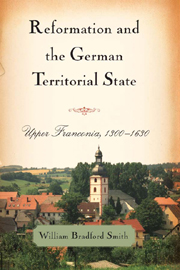Book contents
- Frontmatter
- Contents
- List of Illustrations
- List of Abbreviations
- Acknowledgments
- Introduction
- Chapter 1 Territory and Community
- Chapter 2 Rebellion, Representation, and Reform
- Chapter 3 “Lord in Our Own House”
- Chapter 4 Reformation and Revolution
- Chapter 5 The Limits of Obedience
- Chapter 6 A Plague of Preachers
- Chapter 7 Orthodoxy and Order
- Chapter 8 The Christian Commune
- Chapter 9 Cuius Regio?
- Chapter 10 The Stool of Wickedness
- Conclusion
- Notes
- Bibliography
- Index
Chapter 3 - “Lord in Our Own House”
Published online by Cambridge University Press: 12 September 2012
- Frontmatter
- Contents
- List of Illustrations
- List of Abbreviations
- Acknowledgments
- Introduction
- Chapter 1 Territory and Community
- Chapter 2 Rebellion, Representation, and Reform
- Chapter 3 “Lord in Our Own House”
- Chapter 4 Reformation and Revolution
- Chapter 5 The Limits of Obedience
- Chapter 6 A Plague of Preachers
- Chapter 7 Orthodoxy and Order
- Chapter 8 The Christian Commune
- Chapter 9 Cuius Regio?
- Chapter 10 The Stool of Wickedness
- Conclusion
- Notes
- Bibliography
- Index
Summary
The history of the late-medieval reformatio in the lands of the Franconian Hohenzollerns illustrates the tensions inherent in magisterial attempts at religious reform. As in Bamberg, the process of religious reform during the fifteenth century was closely tied to the problem of territorial consolidation. The Hohenzollern domains comprised a series of small lordships strewn across Franconia, stretching from the Swabian Alb in the west to the Bohemian Forest in the east. For administrative purposes, the lands were organized into three regions: the Niederland in middle Franconia, the Unterland in the upper Aisch valley, and the Oberland. The latter, in the highland region of upper Franconia, was poor but strategically vital, lying across the main lines of communication between Bohemia and the Rhineland and between Brandenburg and Bavaria. The Hohenzollerns had sought to capitalize on their relationship with the emperors to consolidate their domains and acquire the Upper Palatinate, but the ambitions of Charles IV and the house of Wittelsbach ultimately frustrated their plans. Although the acquisition of Brandenburg by Margrave Friedrich I certainly raised the dynasty to new heights, in the short term it merely exacerbated the fragmentary nature of the Hohenzollern domains. Friedrich I passed to his son Albrecht Achilles a motley collection of lands with no common identity except the person of their prince.
- Type
- Chapter
- Information
- Reformation and the German Territorial StateUpper Franconia, 1300–1630, pp. 44 - 58Publisher: Boydell & BrewerPrint publication year: 2008



